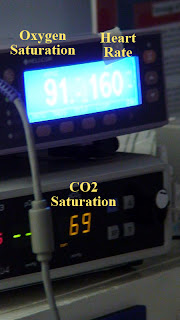I mentioned that I'd be posting an all-science entry for those that are interested in the details of what's flowing in and out of Andrew on a daily basis. Here it is. If you're bored by this sort of thing, skip it and take a look at the pictures of Andrew below.
First, let's start with liquid inputs. The rack below is attached to IV bags (hung above) and various lines on Andrew's arteries (the tubes dangling below). They had to add the top row when they switched to a constant paralytic drip the other day. The "nutrient" IV contains various vitamins and other sustenance. The "fat" IV contains pure lipids to allow him to gain weight while not being fed normal food/milk. The heparin is very diluted, and is on there solely to keep his arterial line flowing well...if it weren't there, blood could clot in the line. The syringe mount is where additional drugs (morphine, Ativan, fentanyl) are added via syringe...the mechanism actually pushes down the plunger at the designated rate.

This is the nitric oxide portion of the ventilator setup. The settings are on the right, in the shaded section, and the three values on the left are measuring the amounts actually entering his ventilator. The left one is the percentage of oxygen. The % of oxygen in the atmosphere is 21%, so the current setting of 34 is providing him extra O2. The maximum is obviously 100%, though it doesn't get that high unless he's seriously desaturating. The nitrogen dioxide value in the middle is a byproduct of nitric oxide and is usually at 0. The third value (20) is the nitric oxide they're giving him, and is supposed to help with pulmonary hypertension. His heart ultrasounds continue to show some hypertension, so this will probably stay pretty high for a while. It is measured in parts per million....the maximum is 40 and the minimum (before removing it entirely) is around 1.

This is the high-frequency ventilator itself. The left number represents the average pressure with which it pushes air into the lungs...we've seen it set anywhere between 13 and 17. The top-right number is the amplitude, which measures how "large" a wave of air is being pushed into his lungs. This has ranged between 28 and 45 in the last couple of weeks. We've never seen them change the other two values (frequency and inspiration percentage) so I'm going to ignore them for now.

Now let's talk about how they check on his progress. First, he's got a big panel with all his major statistics. Down the left side are all the real-time graphs of the values, the right side has the actual numeric values, and the middle has a history of the last thirty minutes, as well as the alarm boundaries. The top value is his heart rate, a simple measure of the beats of his heart....the alarms are set at 100 on the low end and 200 on the high end. Variability is fine, and infants have MUCH higher heart rates than adults. The red line is his blood pressure, and the numbers represent systolic (73), diastolic (41), and the mean (55). The mean can be anywhere between 40 and 70, so his values are great. The purple line is oxygen saturation, measured from a pulse oximeter wrapped around his thumb or fingers. This measures the percentage of oxygenated hemoglobin compared to deoxygenated hemoglobin...basically, the percentage of oxygen the blood is carrying compared to the maximum that it COULD carry. We're looking for something between 95 and 100, though the low 90's is okay. The low alarm is currently set at 87.

The other monitors they watch (in the pic below) are a second pulse oximeter (top) and a TCM (transcutaneous carbon dioxide monitor, bottom). The second pulse oximeter is attached to his foot and measures his pulse and oxygen saturation, both of which are on the monitor above. A difference in the saturation readings between his hand and his foot suggests pulmonary hypertension that is not allowing blood destined for his lower body to be oxygenated....there's really no other reason for the double readings. The TCM is a HIGHLY inaccurate device that gives the nurses a general indication of his carbon dioxide saturation. It has to be calibrated regularly and is still off between 5 and 30 points on almost every reading, when compared to his blood gas results. However, a spiking number on the TCM is often a good first indicator that something is wrong, and gives the nurses a reason to draw blood for an out-of-schedule blood test. We're looking for numbers between 50 and 70 on his blood gases, and preferably on this machine as well.


No comments:
Post a Comment